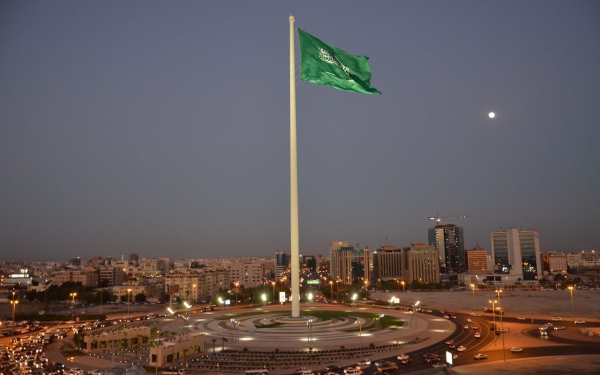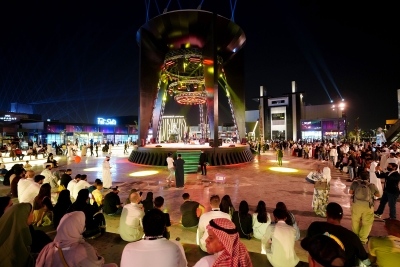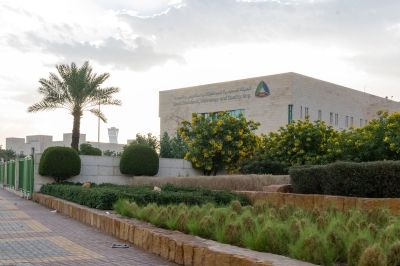

The law of the Flag of the Kingdom of Saudi Arabia is a law that describes the national flag and the flag of His Majesty the King in the Kingdom. It outlines the protocol for raising the national and royal flags, the prohibitions for the usage of the national flag, and their penalties. The law was issued by Royal Decree on February 4, 1973.
Specifications for the national flag and the flag of His Majesty the King
The national flag of the Kingdom is rectangular in shape; its width is equal to two-thirds of its length and its color is green. The color extends from the pole to the end of the flag. In the middle is the Testimony (There is no God but Allah and Muhammad is the Messenger of Allah), with an unsheathed sword drawn underneath parallel to them, the handle of which is directed towards the lower part of the flag. The testimony and the sword are white, clearly visible from both sides. The testimony is scripted in a Thuluth font. The sword is drawn at a length equal to three-quarters of the length of the testimony phrase and at an equal distance on both sides. His Majesty the King shall have a special flag that matches the national flag but differs in that the lower corner of the flagpole side is embroidered with the state's emblem, which is two crossed swords and a palm tree, using gold silk threads.
Saudi flag raising protocol
The national flag is raised within the Kingdom from sunrise to sunset on weekends and holidays on all government buildings and public institutions. When the national flag is raised alongside foreign flags or other banners, the Kingdom's flag shall be raised in the place of honor. If it is raised with only one other flag or banner, the national flag is placed on the right side of the building, which is to the left of a person facing it. If the national flag is raised with multiple foreign flags or banners, it is placed in the center if the number of flags is odd, or in the center towards the right if the number is even. In all cases, the flagpole must be positioned in the center of the building.
No flag or banner is allowed to be placed above the national flag in the same location. In official processions, the national flag is raised in the center of the procession or on its right side, depending on the direction of the procession. It is placed among other flags according to the order specified in the law. In ceremonies and conferences, the national flag can be raised on the walls of the hall or meeting room and should be hung horizontally at a level higher than the speaker and the attendees. When a foreign flag is raised, the rules outlined in the law must be followed, and the flags should be raised on flagpoles. The King's special flag is raised day and night at his official place of work or residence and does not need to be raised in locations where the King is present temporarily.
When His Majesty the King is in his car, His Majesty’s flag is raised at the front of the car on the left-hand side and the national flag at the front on the right-hand side. When His Majesty the King is in his car accompanied by a guest, His Majesty’s flag shall be placed at the front of the car on the right, and the flag of the foreign guest at the front of the car on the left. In the event of a delegate accompanying a foreign guest, the guest’s flag shall be raised at the front of the car on the right, and the Kingdom’s national flag at the front of the car on the left. In all cases in which the foreign guest does not have a special flag, the national flag of his country is raised in place of his own flag.
Raising the national flag on Saudi ships and vessels
The national flag shall be raised on Saudi ships or vessels for navigation on the high seas while they are in any port, from sunrise to sunset, upon entering or leaving any port, when passing within sight of another ship, port, fort, artillery center, or lighthouse, and upon the request of any warship. Additionally, the flag is raised if any distinctive mark or signal is displayed on the ship or naval vessel.
The national flag shall be raised on the back of the ship or marine vessel at the tip of the inclined arm in the stern mast. The national flag is raised continuously day and night on every foreign ship or vessel, commercial or military, while it is within the territorial waters of the Kingdom. Additionally, the national flag shall be raised on inland navigation vessels at the stern from sunrise to sunset, on Fridays, holidays, and all other special occasions.
Prohibitions on the use of the national flag
The national flag, the flag of His Majesty the King and all other Saudi flags bearing the statement of the testimony 'There is no God but Allah and Muhammad is the Messenger of Allah' or a Quranic verse shall never be flown at half-mast. Additionally, the national flag or the flag of His Majesty the King shall never touch the surfaces of land and water. It is prohibited to be used as a trademark for commercial advertising purposes, or any purpose other than those stipulated in the law. It is prohibited to raise the national flag if faded in color or in poor condition. When the national flag becomes old or is in such a bad condition that it is no longer usable, it is burned by the party that uses it.
Military members must salute the national flag and the royal flag when they pass by, during military parades, or when these flags are seen in military parades or take their place in the parades, as well as when they are being raised or lowered on their flagpoles. Anyone who publicly or in a public place, drops, destroys, or insults the national flag, the royal flag, or any other emblem of the Kingdom or a friendly foreign country, out of hatred or contempt for the authority of the government or those countries, shall be punished by imprisonment for a term not exceeding one year, or a fine not exceeding SAR3,000, or both.
Related quizzes
Related articles

